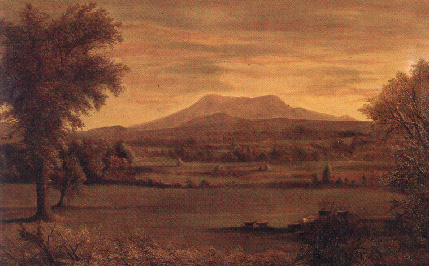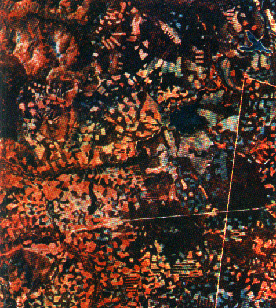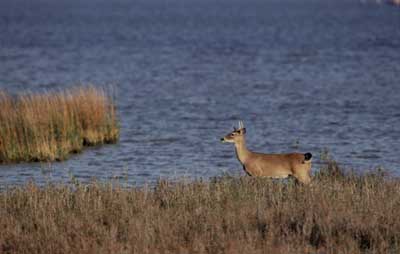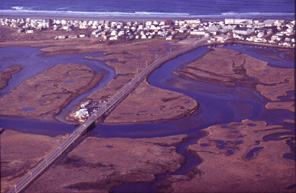
Conservation of Natural Resources
Background | Data | Dates | Information | Essay | Conservation defined | Argument | Aldo Leopold | Conclusion
Gifford Pinchot later recalled:
"It had never occurred to us that we were all parts one of another. And the fact that the Federal Government had taken up the protection of the various natural resources individually and at intervals during more than a half-century doubtless confirmed our bureaucratic nationalism...."
"The forest and its relation to streams and inland navigation, to water power and flood control, to the soil and its erosion; to coal and oil and other minerals; to fish and game; and many another possible use or waste of natural resources–these questions . . . . were not isolated and separate problems . . . .Suddenly the idea flashed through my head that there was a unity in this complication–that the relation of one resource to another was not the end of the story."
"Seen in this new light, all of these separate questions fitted into and made up the one great central problem of the use of the earth for the good of man."
"Here, all of a sudden, was the whole landscape."
"It took time for me to appreciate that here were the makings of a new policy, not merely nationwide, but worldwide in its scope––fundamentally important because it involved . . .the welfare . . . the very existence of men on earth."
"McGee became the scientific brains of the new movement. With his wide general knowledge and highly original mind we developed, as I never could have done alone, the breadth and depth of meaning which lay in the new idea."
"It was McGee, for example, who defined the new policy as the use of the natural resources for the greatest good for the greatest number for the longest time."
"Launching the Conservation movement was the most significant achievement of the Theodore Roosevelt Administration, as he himself believed."
Gifford Pinchot "The Birth of Conservation", in Roderick Nash, The American Environment, (1975), pp. 40-41.
"The land was ours before we were the lands."

Mount Greylock was the scenic inspiration for Herman Melville's great whale: Moby Dick.
Background | Data | Dates | Information | Essay | Conservation defined | Argument | Aldo Leopold | Conclusion
“Science of the Global Environment”
“...this powerful cosmic force. The radiations that pour upon the Earth
cause the biosphere to take on properties unknown
to lifeless planetary surfaces, and thus transform the face of the Earth.”
Vladimir Ivanovich Vernadsky, 1926: Biosfera
Climate historical records from Antarctic ice cores reveal carbon content of the atmosphere is at a 500,000 year high point.
Ice cores from Antarctica, the Vostok station reveal that the current level of carbon dioxide in the environment has not been at this concentration since 417,000 years ago. By interfering with the carbon cycle, human industrial activity and the scale of mass consumption are the primary reasons for a growing instability in climate that generates extreme weather conditions.
“The totality of life, known as the biosphere to scientists
and creation to theologians, is a membrane of organisms wrapped around the earth
so thin …yet so internally complex that most species comprising it remain undiscovered.”
p. 3. Wilson, The Future of Life,
(2002).
Information | Data | Dates | Essay | Argument | Conclusion | Definitions
Dates: 1815 to 1940: critical 125 years
1828-31 federal forestry experiment reserve–protected live oak groves, on Santa Rosa Island, Florida.
1832 George Catlin proposes a national park for wild things.George Catlin, artist of the Great Plains
1848 The defeat of Mexico brings in California,New Mexico, Colorado, Utah, Nevada, Arizona & Wyoming areas into the Union as territories.
1849 US Department of Interior created. (USDI)1862 US Department of Agriculture (USDA) est. to assist farm research.
1862 Morril Land Grant College Act for the study of agriculture & manufacture.
1863 National Academy of the Sciences founded to advise federal government .
1964 George Perkins Marsh published MAN & NATURE.
1864 Yosemite Valley, California, reserved by Lincoln as a State park.Half Dome, Yosemite Valley National Park
1881 Division of Forestry created in USDA (1862).
1885 New York & Ontario create Niagara Reservation at the falls.
1885 New York State creates the Adirondack Forest Preserve.
1885 The origins of the Biological Survey est. in the USDA, from the old Fish Commission.
1891 The Forest Reserve Act permits Presidents to set aside public forests.
1891 California transfers Yosemite State Park to the National government.
1897 Forest Management Act defines the purpose of Forest Reserves.Sequoia sempervirens, or the coastal redwood forests of the Pacific coast.
1902 Reclamation (Newlands') Act creates the Bureau of Reclamation/USDI.
1905 Transfer of the Forest Reserves from USDI to USDA.
1906 Antiquities Act creates a system of National Monuments.
1906 Pelican Island wildlife refuge among the earliest est. in the lower 48 states.
1907 Inland Waterways Commission created to improve river navigation.1907 National Governors' White House Conference on Conservation.
1916 National Park Service created by Congress in the USDI
1940 The Fish and Wildlife Service created
Population change | Change in United States Population
![]()
Data, Federal Bureaus:
The floor of Hetch Hetchy Valley as painted by Albert Bierstadt in the 19th century.
Information | Data | Dates | Essay | Argument | Conclusion | Definitions
Conservation is defined as prevention from harm, loss or decay; protection from wasting away, or being used up. It is a noun. Its root word is maintain, which is a verb. While preservation is the retention of a traditional or inherited quality or character; both words were synonymous until 1900 when a series of controversial decisions about forests, reservoirs, drilling for oil and parks led to a schism in the conservation movement.
|
Protect, |
conservation | preservation |
|
character |
quantitative |
qualitative |
|
explanation |
prevent harm loss or
decay |
harbor, nourish, encourage |
|
example |
fisheries, wildlife,
forests |
capital, species, conditions |
| time | Future oriented | Past oriented |
|
Forestry |
Board feet of timber | Species richness & habitat diversity |
|
Water resources |
Cubic flow of water | Total Maximum Daily loads |
|
Fisheries |
restock from hatcheries | predator & prey food pyramid |
|
Wildlife |
Game protection | non-game species protection |
Compare to capacity of an area.
unseen processes | changes in the life sciences | protecting common property | wetlands
Information | Data | Dates | Essay | Argument | Conclusion | Definitions
Context:
Real evidence for impacts of forestry practices.
 This
is a landsat photograph of areas in an Oregon forest that have been logged by
the clear-cut method. The consequences of the forest management practices leads
to fragmentation of the plant and animal habitat with a loss of poorly adapted species, specialists,
or organisms dependent on uninterrupted forests. The challenge is for us to better account for the many ecosystem services that society relies on.
This
is a landsat photograph of areas in an Oregon forest that have been logged by
the clear-cut method. The consequences of the forest management practices leads
to fragmentation of the plant and animal habitat with a loss of poorly adapted species, specialists,
or organisms dependent on uninterrupted forests. The challenge is for us to better account for the many ecosystem services that society relies on.
Forests provide:
unseen processes | changes in the life sciences | protecting common property | wetlands
Wetlands also have many values.
"But, in terms of 'conservation' in
the late late 1990s, I do not agree with your narrow definition of 'conservation’.
Myself and many colleagues, land holders and land managers nowadays treat conservation as one of many uses of natural resources (in this case wetlands).
In a broader sense, others link conservation with sustainable use (development) and do not concern themselves with splitting hairs over word usage.
In our national context, we have a policy of Ecological Sustainable Development which calls for equity between ecological, economic and social aspects of resource management. I am not sure how this policy was derived, but it tends to sidestep time-wasting divisions due to traditional and less-traditional adherence to terminology.
But, the real point about Ramsar is NOT the listing of sites. Its about the
 Wise
Use of ALL wetlands. Site listing may
be a flagship symbol of commitment or obligation, but it is next to meaningless
without the actions needed to ensure wise use of all wetlands. And within wise
use I'm more than happy to encompass "conservation" which may or may
not equate with "preservation". Thus, the key point is maintenance
of the ecological character of the wetland(s), and we definitely require greater
advocacy in this direction if the Ramsar Convention is to achieve the goals
its Parties have accepted."
Wise
Use of ALL wetlands. Site listing may
be a flagship symbol of commitment or obligation, but it is next to meaningless
without the actions needed to ensure wise use of all wetlands. And within wise
use I'm more than happy to encompass "conservation" which may or may
not equate with "preservation". Thus, the key point is maintenance
of the ecological character of the wetland(s), and we definitely require greater
advocacy in this direction if the Ramsar Convention is to achieve the goals
its Parties have accepted."
Max Finlayson
Branch Head, Wetland Ecology & Conservation
Supervising Scientist Group ERISS,
Locked Bag 2 Jabiru, NT 0886, Australia
maxf@eriss.erin.gov.au
unseen processes | changes in the life sciences | protecting common property | wetlands
Information | Data | Dates | Essay | Argument | Conclusion | Definitions
UK CONSERVATION SCIENTISTS GROUP
DEFINITION OF A CONSERVATION SCIENTISTThe role of a Conservation Scientist
- Cooperate with other disciplines
- Investigate and monitor Cultural Heritage and its environment to facilitate conservation and preservation.
- Develop and evaluate conservation concepts, materials and methods.
- Define standards and guidelines
- Provide diagnosis before, during and after conservation interventions
- Conduct research on causes and mechanisms of deterioration
- Interpret scientific results to the benefit of the conservation of Cultural Heritage
- Communicate the scientific principles of conservation
- Promote scientific research in conservation
Information | Data | Dates | Essay | Argument | Conclusion | Definitions
Aldo Leopold, wildlife biologist, author and conservationist.
The skills required of conservationist:
- A recognized qualification in one of the natural or physical scientific disciplines.
- Knowledge of the relevant aspects of conservation.
- Ability to solve problems
- Ability to formulate and carry out research
- Ability to formulate practical solutions
- Ability to work in an interdisciplinary team
- Ability to communicate effectively
- Ability to manage self and teams
unseen processes | changes in the life sciences | protecting common property | wetlands
Information | Data | Dates | Essay | Argument | Conclusion | Definitions